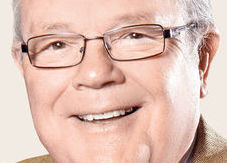By Peter W. Wagner
Some of you may remember the story, strongly circulated a decade ago, about a man who sold hot dogs along the side of a road.
The man didn’t hear very well so he didn’t have a radio. He had eye problems, so he didn’t read the newspaper. But he sold great hot dogs and had signs all along the highway promoting their fantastic taste and great price.
 Every day he would stand beside the road shouting “Hot dogs, get your hot dogs!” and people bought them. Soon he had to increase his meat and bun orders and purchase a bigger stove to handle the growing demand.
Every day he would stand beside the road shouting “Hot dogs, get your hot dogs!” and people bought them. Soon he had to increase his meat and bun orders and purchase a bigger stove to handle the growing demand.
One day, his son came home from college to help during vacation. “Father,” the son said, “haven’t you been following the news? There’s a big recession around the world. The European situation is terrible. The domestic situation is worse.”
Whereupon the father thought to himself “My son is going to college. He reads the papers and listens to the radio. He ought to know the current situation.” So, the father reduced his meat and bun orders, took down his signs and quit standing by the highway trying to sell hot dogs. His hot dog sales fell almost overnight.
“You were right,” the father told his son. “We are in the middle of a great recession.”
Print advertising is facing a similar mindset
The problem facing local papers is we’ve stopped refuting the self-serving, biased stories radio, TV and social media are spreading about us. It seems none of other media can admit that many papers are still doing well.
I watched an excellent news report about a successful, new, paid circulation newspaper on a top-50 market TV station last week. Located in a small community near the station’s metro market, the paper is thriving by providing their readers local news, features, sports stores and opinions not available anywhere else.
The pre-recorded feature was positive and friendly. But the local anchor couldn’t leave it there. When the feature was finished, he had to comment “Newspaper readership has been falling, annually, for the last number of years.”
Fair and balanced? No! What he didn’t say – and no local or national television operations ever admits – is the nightly audience on CBS, NBC and ABC stations has been falling for an even longer period.
During the years Walter Cronkite anchored “CBS Evening News” over 27 million viewers watched that program nightly. Today, the evening news programs on all three original networks combined is smaller than the Cronkite total.
What happened? Viewers now have more choices. More choices for following the news and more choices of programs to watch instead of the news. Today the average home, with the explosion of cable, gets 118 channels. Around-the-clock television news reports have been available since CNN started broadcasting in 1980. Beyond CNN and Fox News there are at least a dozen additional channels blasting out around-the-clock news stories and opinions.
But the once Big Three networks never report their declining viewership. Nor do they report the losses they are experiencing to streaming networks. This past year, according to Hub Entertainment Research, 71 percent of American homes subscribed to Netflix, Hulu or Amazon. Those direct-to-consumer networks are succeeding and taking huge numbers from traditional over-the-air TV stations. And they are doing it by providing fresh and original content.
Who would have thought, 10 years ago, that a non-traditional network, Hulu, would win an Emmy for Outstanding Drama Series with its “The Handmaid’s Tale”?
It is time to tell our story
I am not advocating that local papers should attack other media the way the competition does us. I’d hope we would raise above that childish cat-calling. But it is time for community papers to take a stand, draw a line and tell their important story.
The sharing of printed information has been with us since 59 B.C. That was the year Julius Caesar ordered that a daily list of announcements be carved onto a stone tablet and displayed in a public place.
The need for community papers will always be with us as a permanent record of the mood and important happenings taking place.
Paid circulation and free distribution papers remain the most economical and vital way to share breaking news, honest facts and great opportunities. They are pre-edited, easily portable and provide important details not found anywhere else.
The problem with newspapers today is we are not telling out story. Yes, social media can be free, but it is also limited to the few buyers signed on as “friends.” Newspapers, often shared by two or more families, touch more potential buyers, create a bigger buyer buzz and stay around the house long after an email has disappeared into distant space.
To put it bluntly, it is time for newspaper people to stop letting others push them around and to start telling their story and selling their fantastic value. We need to produce and promote our fun, fact-filled newspaper and let the world know we are succeeding by delivering important, fresh and original content they need and want.
 Nevada Press Association The best in Nevada journalism since 1924
Nevada Press Association The best in Nevada journalism since 1924

Yes, let’s hear it for the local community newspapers! The local news that is important in my community will not be shown elsewhere and I am grateful that our local newspaper is still “hanging on.”